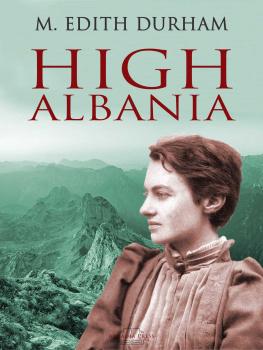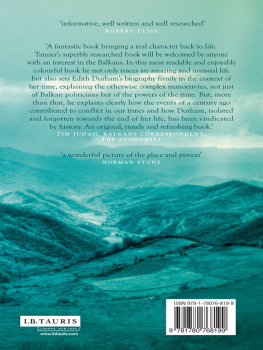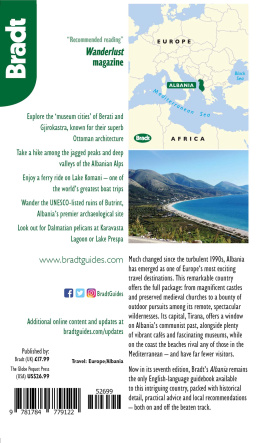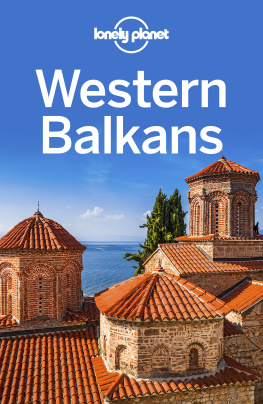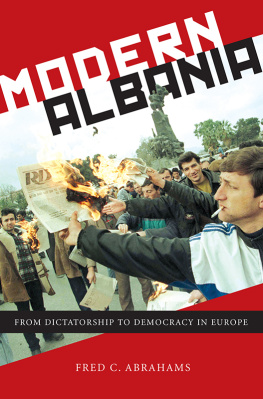DEDICATED
TO
MY SISTER NELLIE
OhwerebackintheBalkansagain,
Backtothejoyandthepain
Whatifitburnsoritblowsoritsnows?
WerebacktotheBalkansagain.
Back, whereto-morrowthequickmaybedead,
Withaholeinhisheartoraballinhishead
Back, wherethepassionsarerapidandred
Oh, werebacktotheBalkansagain!
S ONG OF THE B ALKAN P ENINSULA .
PREFACE
IF a book cannot speak for itself, it is idle to speak for it. I will waste but few words on a Preface. In my two previous Balkan books I strove to give the national points of view, the aims and aspirations, the manners and customs, of the Serbs and of the mixed population of Macedonia.
I would now do the same for the people of High Albania.
From the mass of material accumulated in an eight months tour, together with that collected on previous visits to Albania, it is hard to know what to select, and want of space has forced me to omit almost as much as I have put in, of folklore, custom, and tradition.
The land is one so little known to English travellers that I have given rather a comprehensive view of it as a whole than details of any special branch of study, and have reported what the people themselves said rather than put forward views of my own which are but those of an outsider. Of outsiders views on Balkan problems we are, most of us, tired.
For any success I may have obtained, I am indebted entirely to the kind and most generous help I met on the way from all and sundry more especially to the Franciscans and Mission priests of the mountains, and to my guide Marko; but also to my hosts and guides of all races and religions. Faithful, courageous, and hospitable, it is perhaps written in the Book of Fate that I shall see many of them no more, but if a Man be Gracious and [Page] Courteous to Strangers, it shewes he is a Citizen of the Worlde; and that his Hearte is no Island, cut off from other Lands, but is a Continent that joynes them. And they will not have passed across my life in vain, if from this brief record some few readers learn a truer insight into the character of the mountain tribesman
Lastly, I would say that, though I made very careful inquiry in many places before recording any custom, errors must have crept in, and for them I alone am responsible.
M.E.D.
September 1909.
CHAPTER I: THE LAND OF THE LIVING PAST
Of old sat Freedom on the heights
THE great river of life flows not evenly for all peoples. In places it crawls sluggishly through dull flats, and the monuments of a dim past moulder upon the banks that it has no force to overflow; in others it dashes forward torrentially, carving new beds, sweeping away old landmarks; or it breaks into backwaters apart from the main stream, and sags to and fro, choked with the flotsam and jetsam of all the ages.
Such backwaters of life exist in many corners of Europe but most of all in the Near East. For folk in such lands time has almost stood still. The wanderer from the West stands awestruck amongst them, filled with vague memories of the cradle of his race, saying, This did I do some thousands of years ago; thus did I lie in wait for mine enemy; so thought I and so acted I in the beginning of Time.
High Albania is one of these corners. I say High Albania advisedly, for the conditions that prevail in it are very different from those in South Albania, and it is with the wildest parts of High Albania alone that this book deals.
The history of Albania, a complicated tale of extreme interest, remains to be written strange that it should be so. The claims of Greek, Bulgar, and Serb in the Balkan peninsula are well known; so are the desires of Austria, Russia, and Italy. But it has been the fashion always to ignore the rights and claims of the oldest inhabitant of the land, the Albanian, and every plan for the reformation or reconstruction of the Near East that has done so has failed.
Constantinople, says the Albanian, is the key of the Near East, and Albania is the key of Constantinople.
The history of every people is a great epic, the writing of which is beyond me. The following brief sketch shows only the passing of the peoples that have swayed the fortunes of North Albania, but never yet subdued its stubborn individuality.
IllyrianPeriod (fromabout 700 B.C. to 230 B.C.). A fierce tribal people, known as Illyrians, are recorded as dwelling in the lands now known as Montenegro, High Albania, the Herzegovina, and Bosnia. About 300 B.C. they were invaded by the Celts, who have probably left a deep mark on the people of to-day by the infusion of Celtic blood.
RomanPeriod. Fierce fighters and inveterate pirates, the Illyrians brought down upon themselves a Roman punitive expedition in 230 B.C., and, after a long struggle, Illyria became a Roman province. Gentius, last king of Illyria, was defeated and captured at Scodra in 169 B.C. The land must have been thickly populated, for the Romans were long in subduing it. Thousands of prehistoric graves exist in vast cemeteries throughout Bosnia and the Herzegovina similar ones are found in Servia, Montenegro, and High Albania. They yield many bronze and iron objects of the highest interest, for the patterns are still worn, or have been till recently, by the peasants of Bosnia, Servia, Albania, even of Bulgaria. The rayed ball or circle is not only a common pattern in silver, but is also a traditional tattoo pattern.
Rome found some of her best soldiers among the fighting tribesmen, and more than one Emperor Diocletian and Constantine the Great, and many of lesser note, were of native blood.
In the mountains, it would seem the natives retained their own speech throughout. In the fat plain lands of the peninsula the Romans left Latin dialects. The Roumanian language still survives. The Latin dialect of Illyria, spoken universally in the coast towns in the Middle Ages, died out at the end of the nineteenth century, on the island of Veglio.
Christianity reached the Dalmatian coast as early as the first century. In the interior it made little progress till the fourth.
The transference of the capital of the Roman Empire to Byzantium had but little effect on Illyria, which remained part of the Patriarchate of Rome. And to Rome the descendants of the Illyrians have to a large extent remained faithful.
ServianPeriod (SeventhCenturytoFourteenthCentury). The next event of importance was the Slavonic invasion. The ancestors of the modern Servians poured into the peninsula in irresistible numbers, overpowered the inhabitants, and reached the Dalmatian coast, burning the Roman town of Salona, 609 A.D. Serb influence grew stronger and stronger. At first as tribes suzerain to Byzantium, and then as an independent kingdom, they dominated the west side of the peninsula, and finally, under the Nemanja kings in the thirteenth and fourteenth centuries, almost the whole of it. The Venetians came in as protectors of the remaining Latin coast population in the eleventh century, and crept by degrees along Dalmatia.

